Jaguar E-Pace vs VW T-Roc – Performance, range & efficiency compared
Everyday use, family trips or long-distance drives – here’s where the differences show.
Discover whether Jaguar E-Pace or VW T-Roc fits your lifestyle better.
Costs and Efficiency:
When it comes to price and running costs, the biggest differences usually appear. This is often where you see which car fits your budget better in the long run.
VW T-Roc has a evident advantage in terms of price – it starts at 26400 £, while the Jaguar E-Pace costs 32400 £. That’s a price difference of around 5962 £.
Fuel consumption also shows a difference: Jaguar E-Pace manages with 1.40 L and is therefore convincingly more efficient than the VW T-Roc with 5.50 L. The difference is about 4.10 L per 100 km.
Engine and Performance:
Power, torque and acceleration are the classic benchmarks for car enthusiasts – and here, some clear differences start to show.
When it comes to engine power, the Jaguar E-Pace has a clearly edge – offering 269 HP compared to 150 HP. That’s roughly 119 HP more horsepower.
In acceleration from 0 to 100 km/h, the Jaguar E-Pace is noticeable quicker – completing the sprint in 7.30 s, while the VW T-Roc takes 8.90 s. That’s about 1.60 s faster.
In terms of top speed, the VW T-Roc performs hardly perceptible better – reaching 212 km/h, while the Jaguar E-Pace tops out at 211 km/h. The difference is around 1 km/h.
There’s also a difference in torque: Jaguar E-Pace pulls clearly stronger with 540 Nm compared to 250 Nm. That’s about 290 Nm difference.
Space and Everyday Use:
Beyond pure performance, interior space and usability matter most in daily life. This is where you see which car is more practical and versatile.
Both vehicles offer seating for 5 people.
In curb weight, VW T-Roc is distinct lighter – 1465 kg compared to 1783 kg. The difference is around 318 kg.
In terms of boot space, the Jaguar E-Pace offers minimal more room – 494 L compared to 475 L. That’s a difference of about 19 L.
In maximum load capacity, the VW T-Roc performs somewhat better – up to 1350 L, which is about 180 L more than the Jaguar E-Pace.
When it comes to payload, Jaguar E-Pace slight takes the win – 554 kg compared to 515 kg. That’s a difference of about 39 kg.
Who wins the race?
The Jaguar E-Pace proves to be dominates this comparison and therefore becomes our DriveDuel Champion!
Jaguar E-Pace is the better all-rounder in this comparison.

Jaguar E-Pace
Jaguar E-Pace
The Jaguar E-Pace is a compact SUV that combines the brand's signature luxury with a dynamic driving experience. Its sleek design features graceful lines and an assertive stance, making it a standout on any road. Inside, the E-Pace boasts a meticulously crafted interior with high-quality materials and advanced technology, providing both comfort and connectivity for drivers and passengers alike.
details @ media.jaguar.com
@ media.jaguar.com
 @ media.jaguar.com
@ media.jaguar.com
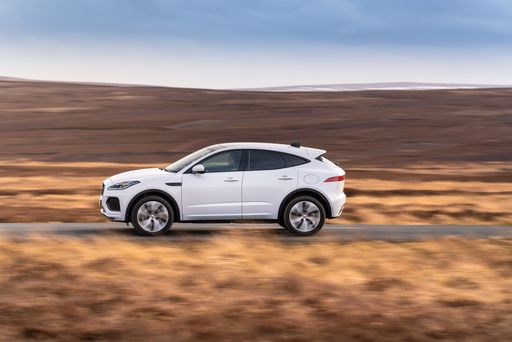 @ media.jaguar.com
@ media.jaguar.com
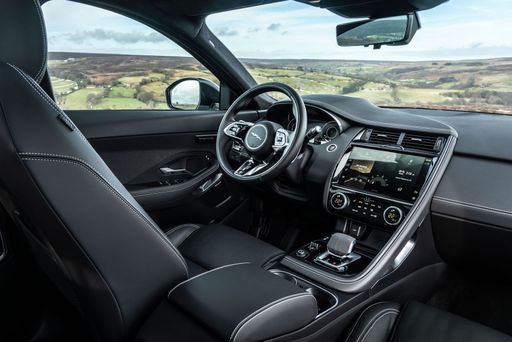 @ media.jaguar.com
@ media.jaguar.com
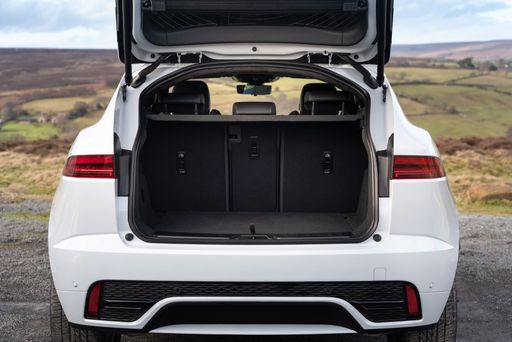 @ media.jaguar.com
@ media.jaguar.com
VW T-Roc
The VW T-Roc seamlessly blends stylish design with practical functionality, making it an ideal choice for those who enjoy both urban and countryside driving. Its modern interior features intuitive technology and comfortable seating, enhancing the overall driving experience. With its robust build and dynamic performance, the T-Roc is equipped to handle various road conditions with confidence.
details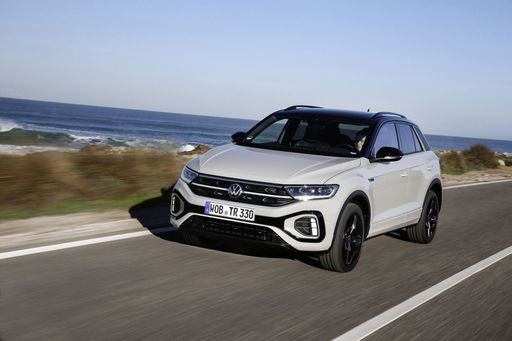 @ Volkswagen
@ Volkswagen
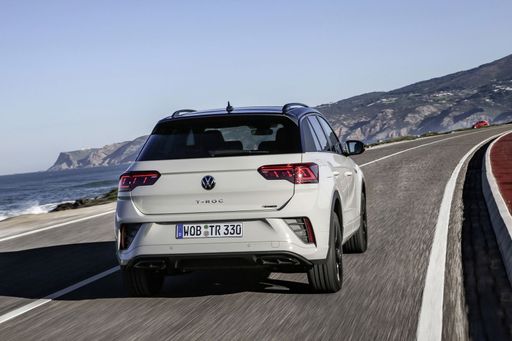 @ Volkswagen
@ Volkswagen
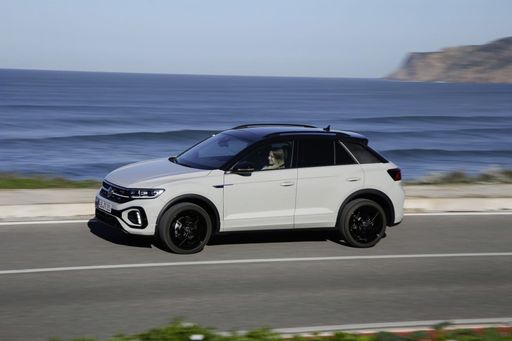 @ Volkswagen
@ Volkswagen
 @ Volkswagen
@ Volkswagen

|

|
|
|
|
Costs and Consumption |
|
|---|---|
|
Price
32400 - 56100 £
|
Price
26400 - 38000 £
|
|
Consumption L/100km
1.4 - 8.2 L
|
Consumption L/100km
5.5 - 6.3 L
|
|
Consumption kWh/100km
-
|
Consumption kWh/100km
-
|
|
Electric Range
69 km
|
Electric Range
-
|
|
Battery Capacity
11.50 kWh
|
Battery Capacity
-
|
|
co2
33 - 185 g/km
|
co2
126 - 143 g/km
|
|
Fuel tank capacity
56 - 67 L
|
Fuel tank capacity
50 L
|
Dimensions and Body |
|
|---|---|
|
Body Type
SUV
|
Body Type
SUV
|
|
Seats
5
|
Seats
4 - 5
|
|
Doors
5
|
Doors
2 - 5
|
|
Curb weight
1783 - 2173 kg
|
Curb weight
1465 - 1539 kg
|
|
Trunk capacity
494 L
|
Trunk capacity
284 - 475 L
|
|
Length
4395 mm
|
Length
4271 - 4373 mm
|
|
Width
1984 mm
|
Width
1811 - 1828 mm
|
|
Height
1648 mm
|
Height
1527 - 1573 mm
|
|
Max trunk capacity
1170 L
|
Max trunk capacity
1350 L
|
|
Payload
497 - 554 kg
|
Payload
368 - 515 kg
|
Engine and Performance |
|
|---|---|
|
Engine Type
Plugin Hybrid, Diesel MHEV, Petrol MHEV
|
Engine Type
Petrol, Petrol MHEV
|
|
Transmission
Automatic
|
Transmission
Manuel, Automatic
|
|
Transmission Detail
Automatic Gearbox
|
Transmission Detail
Manual Gearbox, Dual-Clutch Automatic
|
|
Drive Type
All-Wheel Drive, Front-Wheel Drive
|
Drive Type
Front-Wheel Drive
|
|
Power HP
160 - 269 HP
|
Power HP
115 - 150 HP
|
|
Acceleration 0-100km/h
7.3 - 10.5 s
|
Acceleration 0-100km/h
8.9 - 12.3 s
|
|
Max Speed
190 - 211 km/h
|
Max Speed
187 - 212 km/h
|
|
Torque
260 - 540 Nm
|
Torque
200 - 250 Nm
|
|
Number of Cylinders
3 - 4
|
Number of Cylinders
3 - 4
|
|
Power kW
118 - 198 kW
|
Power kW
85 - 110 kW
|
|
Engine capacity
1498 - 1998 cm3
|
Engine capacity
999 - 1498 cm3
|
General |
|
|---|---|
|
Model Year
2024
|
Model Year
2024 - 2025
|
|
CO2 Efficiency Class
B, G
|
CO2 Efficiency Class
E, D
|
|
Brand
Jaguar
|
Brand
VW
|
What drive types are available for the Jaguar E-Pace?
The Jaguar E-Pace is offered with All-Wheel Drive or Front-Wheel Drive.
The prices and data displayed are estimates based on German list prices and may vary by country. This information is not legally binding.
